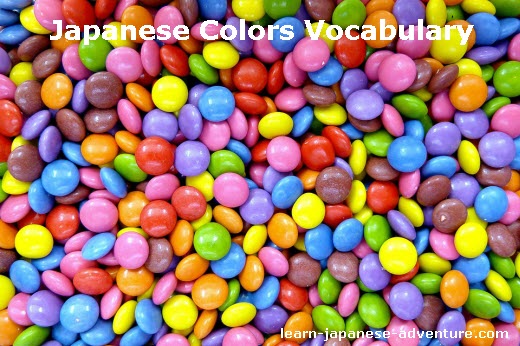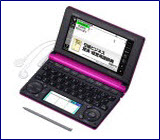- Home
- Japanese Vocabulary
- Japanese Colors
Japanese Colors Words and Vocabulary
This section covers the words and vocabulary used to describe Japanese colors.

Most of the colors in Japanese are ended with the word 色 (iro) with a few exceptions. There are no kanji equivalents for colors using katakana as they are direct translation from English.
It's always interesting to learn the perception of different colors among different cultures.
You probably notice that on the Japanese flag, it's a sun painted in red 赤い日 (akai hi - red sun). But in most other countries, the sun is always yellow or orange.
In funeral the Japanese wear black from head to toe, including men's ties. I just wonder if every man always has a black suit ready in their wardrobe anticipating that he will be wearing it to attend funerals. On the other hand, white color, which is an auspicious color, is always used in weddings.
Let's check out what is the word list for colors in Japanese.
| Kanji | Hiragana or Katakana |
Romaji | Meaning | |
| 1. | 色 | いろ | iro | Color |
| 2. | 白 | しろ | shiro | White |
| 3. | ホワイト | howaito | White | |
| 4. | 黒 | くろ | kuro | Black |
| 5. | ブラック | burakku | Black | |
| 6. | 赤 | あか | aka | Red |
| 7. | レッド | reddo | Red | |
| 8. | 青 | あお | ao | Blue |
| 9. | ブルー | buru- | Blue | |
| 10. | 緑 | みどり | midori | Green |
| 11. | グリーン | guri-n | Green | |
| 12. | 紫 | むらさき | murasaki | Purple / Violet |
| 13. | パープル | pa-puru | Purple | |
| 14. | 黄色 | きいろ | ki iro | Yellow |
| 15. | イエロー | iero- | Yellow | |
| 16. | 茶色 | ちゃいろ | cha iro | Brown |
| 17. | ブラウン | buraun | Brown | |
| 18. | 金色 | きんいろ | kin iro | Gold |
| 19. | ゴールド | go-rudo | Gold | |
| 20. | 銀色 | ぎんいろ | gin iro | Silver |
| 21. | シルバー | shiruba- | Silver | |
| 22. | 桃色 | ももいろ | momo iro | Pink |
| 23. | ピンク | pinku | Pink | |
| 24. | 灰色 | はいいろ | hai iro | Gray |
| 25. | グレー | gure- | Gray | |
| 26. | 橙色 | だいだいいろ | daidai iro | Orange |
| 27. | オレンジ | orenji | Orange | |
| 28. | 水色 | みずいろ | mizu iro | Light Blue |
| 29. | 紺色 | こんいろ | kon iro | Deep Blue / Navy Blue / Dark Blue |
| 30. | 藍色 | あいいろ | ai iro | Indigo Blue |
| 31. | 藤色 | ふじいろ | fuji iro | Light Purple |
| 32. | 焦げ茶色 | こげちゃいろ | kogecha iro | Dark Brown |
| 33. | 山吹色 | やまぶきいろ | yamabuki iro | Bright Golden Yellow |
| 34. | 黄土色 | おうどいろ | oudo iro | Yellow Ocher |
| 35. | 黄緑 | きみどり | ki midori | Yellow Green |
| 36. | 深緑 | ふかみどり | fuka midori | Dark Green |
| 37. | ダークグリーン | da-ku guri-n | Dark Green | |
| 38. | ベージュ | be-ju | Beige | |
| 39. | 朱色 | しゅいろ | shu iro | Vermilion / Scarlet |
| 40. | 茜色 | あかねいろ | akane iro | Madder Red |
| 41. | 銅色 | あかがねいろ | akagane iro | Copper |
| 42. | 青銅色 | せいどういろ | seidou iro | Bronze |
| 43. | ライラック | rairakku | Lilac | |
| 44. | ターコイズ | ta-koizu | Turquoise | |
| 45. | 無色 | むしょく | mushoku | Colorless |
| 46. | カラフル | karafuru | Colorful | |
| 47. | 透明 | とうめい | toumei | Transparent / Clear |
| 48. | 淡い | あわい | awai | Light / Pale |
| 49. | 明るい | あかるい | akarui | Bright |
| 50. | 鮮やか | あざやか | azayaka | Vivid / Vibrant |
| 51. | 薄い | うすい | usui | Light / Faint |
| 52. | 濃い | こい | koi | Dark / Deep Color |
One thing to take note is that the above colors are all nouns. Therefore, when you describe an object with a color, you should add the particle の (no) in between. This is description of noun (NounA no NounB) as taught in basic lesson 3.
For example, 青の車 (ao no kuruma - a blue car), 赤の箱 (aka no hako - a red box), ベージュのかばん (be-ju no kaban - a beige bag), 紺色のシャツ (kon iro no shatsu - a dark blue shirt).
However, a few of the colors have their i-adjective equivalents, they are 白い (shiroi), 黒い (kuroi), 赤い (akai), 青い (aoi), 黄色い (kiiroi). For these few colors, you can describe the object directly without using the の (no) particle.
For example, 白い車 (shiroi kuruma - a white car), 黒い靴 (kuroi kutsu - a black shoe), 赤いぺん (akai pen - a red pen), 青い椅子 (aoi isu - a blue chair), 黄色い紙 (kiiroi kami - a yellow paper).
The above is the word list commonly used to describe Japanese colors. I will continue to collect more color words and add them to the above list.
And if you want to study more vocabulary about colors in Japanese and also how to read them in Japanese, make sure you check out this page talking about more colors.
By the way, this link above is an affiliate link, which means that I would earn a commission if you do end up purchasing the related learning course. It's at no extra cost to you, and please if you have any questions related to this learning course, please let me know and I would be happy to answer them for you.
Buy me a coffee









Facebook Comments
Don’t see the comments box? Log in to your Facebook account, give Facebook consent, then return to this page and refresh it.